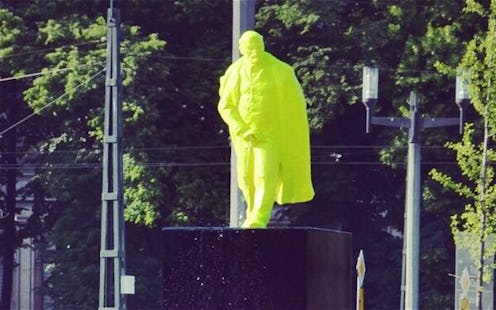News
This Is A Real Statue Of Peeing Lenin
The town of Nowa Huta in Krakow, Poland has put up a neon green statue of Communist leader Vladimir Lenin peeing, and... well, that's basically all we need to say, right? It's a striking artistic achievement, if a bit troubling — the eye-poppingly painted Soviet leader, penis tucked in his hand, a stream of water gushing freely into the basin below. We feel pretty safe in saying it's the best garish public tribute to Lenin's bathroom habits in human history.
The title of the structure is "Fountain of the Future." It was created as part of an art festival in Nowa Huta, and is now something of an international sensation. drawing very understandable attention from tourists and photo-seekers, according to The Telegraph.
The statue now stands on the same site that a very different tribute to Lenin once stood. In 1973, Nowa Huta was still a Soviet-controlled town separate from neighboring Krakow, of which it's now the easternmost district. On April 23 of that year, a bronze monument to Lenin was unveiled, striking a far more triumphant pose than the new one. It stayed in place until 1989, until protests by local citizens caused the tribute to be dismantled, paving the way for this bizarre, new-age replacement.
A leader of the 1917 Russian Revolution and a seismic figure in world history, Lenin sat at the very top of the resulting Soviet Union, but lived for just a short time more. He died of a heart attack in 1924, having suffered three strokes before that, which triggered a massive power struggle among high-ranking members of the Soviet Politburo — Alexei Rykov, Leon Trotsky and Joseph Stalin among them — which ultimately saw Stalin seize power, beginning his 30-year reign.
Lenin iconography has long been controversial, and ex-Soviet states have grappled with the presence of such icons (as well as those in the form of Joseph Stalin) throughout recent years. But the creators of the "Fountain of the Future" clearly had a better, somewhat more subversive idea than just letting the landmark's history go overlooked.
Maybe we shouldn't overthink it — one of the artists behind it, Bartosz Szydlowski, gave The Telegraph an even simpler explanation of the work: that it would show Nowa Huta wasn't "gray and gloomy," but had a "sense of humor."
If that was the goal, we have to offer some hearty congratulations. A town statue may never have demonstrated better humor than this one.
